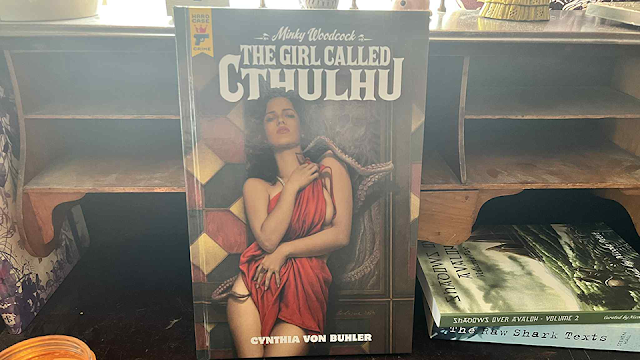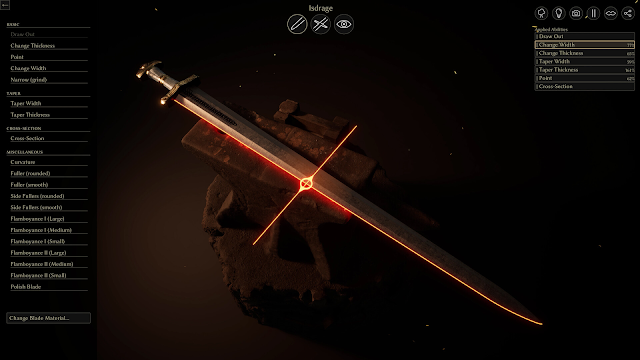Girl by Moonlight: A DMing Check-In
BOOK TOUR: Minky Woodcock: The Girl Called Cthulhu
GAME REVIEW: Bladesong (Story Mode Playtest)
I don't have as much time as I'd like for video games — especially in the summer, when I'm balancing busy multiple busy seasons at multiple jobs. But when something unique comes along, I like to take a break and try it, rather than relying on one of my YouTube faves to play it in the background while I work.
Such is Bladesong, which is not related to my favorite Wizard subclass but is a very cool game where you smith and decorate swords. At the time of this writing, the game is available for playtesting, with a test build showing off both its Story and its Creative modes. As a story-based gamer, I tried out the former (I may give the latter a go later). And while there were elements that were a bit crunchy for someone like me with terrible spatial awareness, the story woven through the gameplay loop was extremely promising.
You play a blacksmith living in an impoverished settlement on the outskirts of a grand city. You've just escaped death and are currently working your way up to a life within the walls of said city; this will involve gaining a reputation and a work permit, and also not having your throat slit in the night by thieves. By day you can explore the camp, make friends (or not), buy wares, and discover more about the world around you. Once that's done, you fill orders for fellow camp residents. And once that's done, you try to make it through the night.
The character selection screen is very basic. You pick a gender, a background, a single possession, and an outlook on life. The second and third of those will affect your stats, with each Background buffing one stat by +3 and unlocking unique dialogue options, and the third optimizing your game depending on how you choose to play. (These bonuses are explained under each choice, giving you plenty of freedom to customize to your liking.) The first choice simply defines how you're addressed, and the fourth... well, I'm not sure yet, other than the fact that it enables an old lady who saved your life to dunk on you one last time before turning you over to the waking world.
Making swords is at the core of this game, and your forge looks pretty rad. At the start of each day, you have a certain amount of action points. Every potential customer requires a certain amount of points to work with, and each will yield experience, coin, and other bonuses. If you're getting tired, there's always at least one quick and dirty repair job you can do for a single action point.
I especially like that there's story embedded in most of these commissions. Sometimes you'll meet a father in need of a simple blade to protect his daughter; often, you'll meet camp dwellers tired of being put upon and desirous of showing everyone else who's boss. You don't have to take every order; and, indeed, I found myself only accepting orders of certain types after a point. Generally anyone who was against the camp's cutthroat thieves was an automatic yes... along with a lady who kept showing up and claiming she could hear beasts skittering in the night. Listen, the city has a magic barrier around it, and it's clearly to keep something out.
The smithing portion is pretty satisfying, and I imagine it's even more fun in Creative mode. I mostly enjoyed filling orders in Story mode, though. This meant making swords to certain specifications: heavy two-handers with leather-wrapped hilts, well-balanced blades, or (on occasion) just something sharp to get the job done. I did run across a work order or two that felt counterintuitive — swords that, based on the game's hints, needed to have both more and less mass at the point. A little more tutorial time spent working on these seemingly conflicting orders would have been helpful... perhaps a "difficult customer" to satisfy before being let out onto the world map. But if you can't seem to get an order filled, you can leave it. You'll sacrifice those action points, but you won't be softlocked.
There was only so much exploring that could be done in the playtest, but what was there was fun. There was an encounter with a thief, which could be solved in a number of ways: arming him, leaving him waiting, or just killing him (if you're strong enough). As I mentioned, I spent a lot of time arming fellow camp members who were also victims of the thief; had the story continued, I wonder if this would have made a difference.
Your choices have at least some effect on your ability to navigate the camp, as you can befriend and help others down on their luck. Also, there is a dog, and yes you can pet it, you can pet the dog, I'm so happy, these devs know what we need in a game.
As for the broader story, there's promise. The playtest ends right after a frankly horrifying reveal, and even the few areas you can explore before entering the city offer enticing details. There's absolutely a world here for those who want to find out more. And I definitely want to find out more.
Bladesong definitely caters to those with better spatial awareness in terms of the actual forging portion of the game, and I can see lots of people getting caught up in the creative aspect. You gain new methods, new tools, and new ornamentations as you go, meaning you can make increasingly elaborate blades. (Which admittedly sounds awesome.) But if you are more story-forward, never fear: this playtest hints at a vast, dark world waiting to be unlocked.
On Generative AI
BOOK TOUR: YAN Vol. 1
TTRPG REVIEW: The Ultimate RPG Worldbuilding Deck
No matter what anyone tells you, you don't need generative AI to help you build a game setting. All you need is some human collaboration—or, failing that, a creative jump-start from James D'Amato.
I've reviewed so many RPG tools from D'Amato here on my blog, from storytelling games to book that help you build a fully fleshed-out character. His latest contribution to the GM's toolkit is The Ultimate RPG Worldbuilding Deck: a set of cards that can be used alone or collaboratively to add details to your campaign or setting.
At the moment, as many of you know, I'm running a Girl by Moonlight campaign. As my players are about to go somewhere new and meet several new people, I figured this was a perfect opportunity to put the latest deck to work. For the purposes of the single session coming up, I pulled two cards from each of the five categories: People, Places, History, Rumors, and Institutions. Since I had a fairly solid idea of where these new elements would fit into the story, I allowed myself to switch out cards if something simply did not fit.
Each card gives you a heading that dictates what this person, place, or thing is. A Thief. A Sad-Sack. A Burial Site. An Accord. And so on. Underneath that, on the top half of the card, is a set of fill-in-the-blank or multiple choice questions. You don't have to create anything whole-cloth for the questions at the top. If you're stuck, you can flip a coin or roll a die to fill in answers.
Once that first half of the card is done, the second half then asks a series of questions based on what you've decided. This is where it's time for your own brain to tick over. But even if you're feeling a little blocked or uncreative, there are two things that make this easy. First, the questions generally start by stating a fact and asking you to elaborate. For example, rather than simply asking "what is this NPC like," the card might tell you that the character has a false exterior, then ask what they are hiding beneath it.
The second thing that helps is that every card asks two questions about how this new story element relates to a PC. For example, which PC does this character become fascinated with? Or, which PC has extra expertise that helps them adapt to a certain new place? I found that, by imagining my group in action, I had more ideas at the ready. This also serves the purpose of ensuring that every new addition serves the party and gives at least one player a chance to shine.
As a multiplayer experience, it's a bit like The Quiet Year, albeit without the mapping element. As players draw cards, they bounce ideas off each other, slowly creating a world that builds on everything that's come before. Much like D'Amato's Oh Captain, My Captain!, this feels like it could also be a great warm-up when played with fewer cards. If you happen to be GMing for a game that encourages collaborative worldbuilding, this could also be a way to get ideas flowing.
I have yet to encounter something from the Ultimate RPG Series that disappoints. Everything I read or play goes directly on my gaming shelf, if not directly into my gaming bag. This series has measurably improved my gaming experience both as a player and a GM, and this in particular is a tool I'll be pulling off the shelf on a regular basis.
The Ultimate RPG Worldbuilding Deck is now available from Adams Media.








